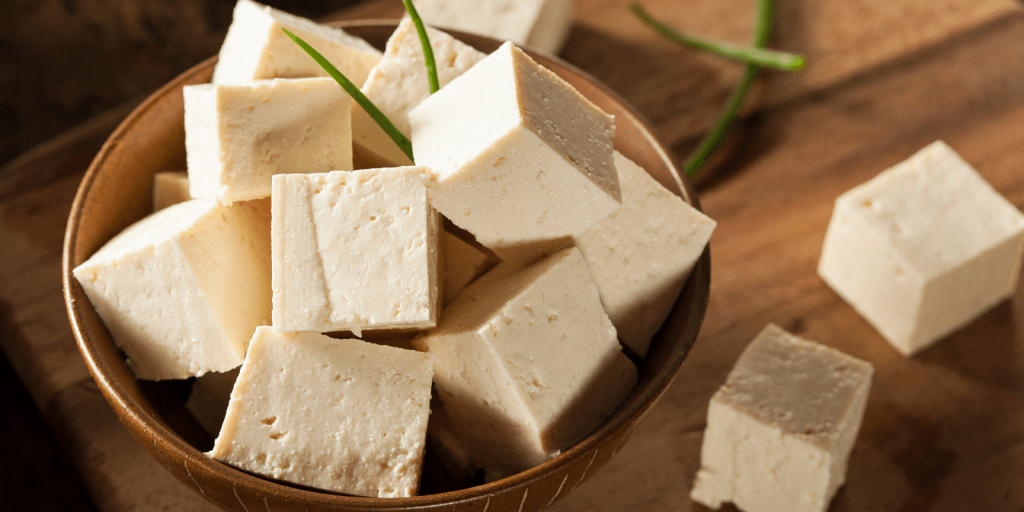Tempeh, tofu and seitan – vegan protein sources

Vegetarian and vegan diets are becoming increasingly popular. This is because awareness is growing and more and more people are finding out that, despite appearances, such a diet does not have to be boring and also poor in protein. Learn about three vegan protein sources that make a diet devoid of or limiting animal products tasty and well-balanced.
Meeting protein requirements is a problem for many people on a diet that limits or eliminates the intake of animal products. The first solution is to introduce more legumes into the diet, such as beans, chickpeas and lentils. However, there are also other products on the market, based on soya or wheat, which are definitely worth using. These are vege sources of protein, but also other vitamins and nutrients. Get to know them!
Tempeh
What is tempeh?
Tempeh is a traditional Indonesian product that is prepared from fermented soybeans, wheat or both. Tempeh has a firm but stringy texture and a slightly nutty flavour.
Ways to use
Tempeh can be steamed, fried or baked. To enhance its flavour, it is often marinated before cooking. This makes it more pronounced and gives the dish a specific aroma.
Nutritional value
Tempeh is a great vegan protein source, as it contains as much as 20 g of protein per 100 g of product. In addition, it is also rich in calcium, which is good news for vegans who are looking for sources of calcium in non-protein products. Due to the fact that it is a fermented product, tempeh can also have a good effect on the gut microflora. Additionally, isoflavones, which are contained in soya beans, can lower blood cholesterol levels.
Tofu – vegan protein source
What is tofu?
Tofu is made from condensed soya milk, which begins to take a solid form under the influence of a coagulant and is then pressed into white blocks. The process of tofu production is similar to cheese making.
Uses
Like tempeh, tofu can also be boiled, baked or fried. It is great for preparing ‘scrambled eggs’ for vegans or as an ingredient in homemade sandwich spreads.
Nutritional value
The nutritional value of tofu depends on the coagulant that was used to prepare it. The protein content is approximately 17 g per 100 g of product. Like tempeh, tofu is also a source of isoflavones, which have a positive effect on lowering blood cholesterol levels. Unfortunately, in addition to the beneficial nutrients, we can find anti-nutrients in tofu. These include phytates and trypsin inhibitors. Phytates can reduce the absorption of vitamins and minerals, while trypsin inhibitors block an enzyme that is essential for the proper digestion of proteins. This can also contribute to impaired digestion of certain ingredients, and can manifest as indigestion and abdominal pain. Cooking, soaking or fermenting soya beans before tofu production, reduces the content of anti-nutritional compounds.
Soy-based products and GMOs
Currently, the USA is the world’s largest producer of soya, and much of the crop comes from genetically modified crops. This modification involves the addition of genes that improve crop growth, pest resistance, nutrient content or ease of cultivation. At the moment, there are no conclusive studies showing the health effects of crops derived from GM crops, but some people are concerned about its effects on health. If you are one of them, when choosing soya-based products, opt for those that say ‘organic’ or ‘GMO-free’ on the label.
Seitan
What is seitan?
Seitan is a plant-based meat substitute made from wheat. We therefore classify it as a vege source of protein. It is made by rinsing prepared wheat dough to remove starch. The result is a mass consisting mainly of protein, which can be seasoned, cooked and used in many dishes. The main ingredient in seitan is vital wheat gluten. Its taste and nutritional value depend on the ingredients used in its preparation.
Ways of use
Seitan can be boiled, baked and fried. Coated and deep-fried, it wonderfully imitates real meat. It is also often used as a meat substitute in pasta dishes or kebabs. It also tastes good as a sandwich topping.
Nutritional value
Seitan contains approximately 20 g of protein per 100 g of product. As the main ingredient from which seitan is prepared is vital wheat gluten, some amount is still present despite being washed out. This makes seitan unsuitable for those suffering from celiac disease or gluten intolerance. The fact that the source of protein in seitan is wheat, on the other hand, is good news for anyone who cannot consume soya and products that have it in their ingredients.
Fitatu® App
Download the application from the Play Store or Apple Store and start counting your macros with us!
Do you prefer the web version? No problem. A basic web version is prepared for our subscribers. And now you can use the PROTEIN-K discount code for 29% off your monthly Fitatu® Premium.
What else can you find in Fitatu® Premium?
- over 2000 recipes plus several new ones every month
- additional plans for intermittent fasting
- the ability to create shopping lists
- a choice of six ready-made menus full of meals to choose
- filtering products and recipes
- more synchronization with fit apps
- access to your Meal Plan in the web version
- no ads!
Bibliography:
- Madhu Kamle, Pradeep Kumar, Jayanta Kumar Patra, Vivek K Bajpai, Current perspectives on genetically modified crops and detection methods, 3 Biotech. 2017 Jul;7(3):219.
- Melvin J Oliver, Why we need GMO crops in agriculture, Mo Med. 2014 Nov-Dec;111(6):492-507.
- Krishan Kumar, Geetika Gambhir, Abhishek Dass, Amit Kumar Tripathi, Alla Singh, Abhishek Kumar Jha, Pranjal Yadava, Mukesh Choudhary, Sujay Rakshit, Genetically modified crops: current status and future prospects, Planta. 2020 Mar 31;251(4):91.
- Weston Petroski, Deanna M. Minich, Is There Such a Thing as “Anti-Nutrients”? A Narrative Review of Perceived Problematic Plant Compounds, Nutrients. 2020 Oct; 12(10): 2929.
- Wai Chuen Choi, Tim Parr, Yin Sze Lim, The impact of four processing methods on trypsin-, chymotrypsin- and alpha-amylase inhibitors present in underutilised legumes, J Food Sci Technol. 2019 Jan; 56(1): 281–289.
- Runni Mukherjee, Runu Chakraborty, Abhishek Dutta, Role of Fermentation in Improving Nutritional Quality of Soybean Meal — A Review, Asian-Australas J Anim Sci. 2016 Nov; 29(11): 1523–1529.
- Gianluca Rizzo, Luciana Baroni, Soy, Soy Foods and Their Role in Vegetarian Diets, Nutrients. 2018 Jan; 10(1): 43.





